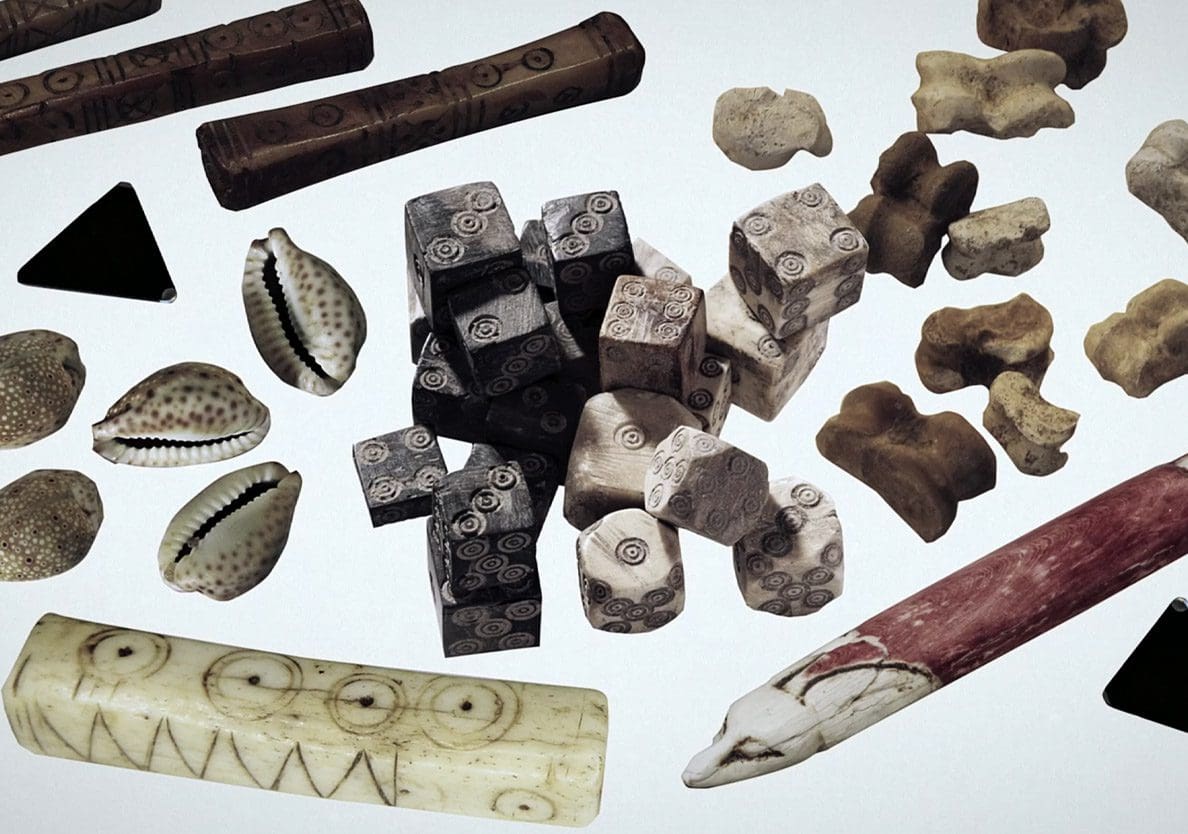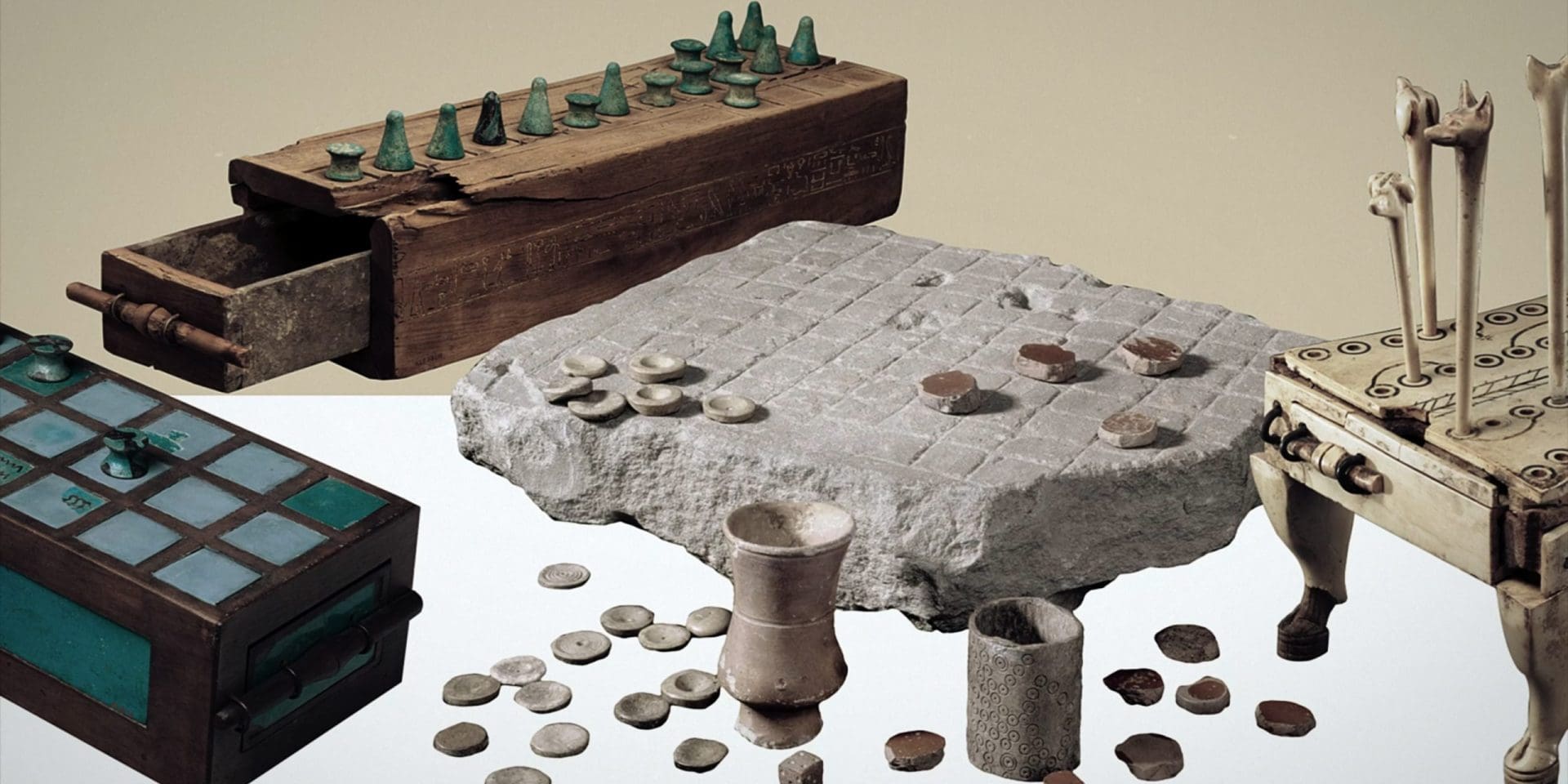Games and board games are sometimes seen as a modern luxury, but history shows that humans everywhere and in every-time have invented and played games. As far back into human history as modern man can see, there is evidence of gameplay. The earliest examples come from the Neolithic time period (8300-4500BC)[1], and often include mancala type boards carved into stone floors; These games have rows of holes in which pebbles, seeds, bones or other small objects would be placed as game pieces, racing or battling other players for pieces. If not right away, this style of game was eventually carved into portable boards made of wood, clay, stone or even ivory.[2] Its dice and possibly its point counters would have been made of similar materials (clay, stone, wood, ivory, beans, pebbles, sticks etc.), or sheep ankle bones (astragali) were a popular form of dice.


Dice themselves have an incredibly long history both as a way to move in board games, and as games themselves. The most ancient dice known today date to the third millennium BC, from Mesopotamia and modern-day Pakistan.[3] Like today, dice came in many different shapes, sizes and materials, and our most popular form of dice are represented in the ancient world as well.[4] In the Roman Empire dicing was nearly a sport; competitive, professional dicing leagues existed and profits by gambling could become a man’s full-time job.[5] Some of the most famous gamblers were the Emperors themselves (Caligula 37-41AD, Claudius 41-54AD, Nero 54-68AD).[6]
“The oldest complete board game found is referred to as the Royal Game of Ur. It dates to a time before Abraham in the middle of the third millennium BC.”
The oldest complete board game found is referred to as the Royal Game of Ur or Twenty Squares. It dates to a time before Abraham in the middle of the third millennium BC (c. 2500BC), and the game’s date of invention must have been before this. Twenty Squares was played all over the ancient world, and excitingly, the modern curator of the British Museum (Irving Finkel) translated a cuneiform tablet that gave instructions on how to play at least one ancient version of it, it was essentially a race. This Twenty Squares game is related to another game that was popular in ancient Egypt[7] and was widely played in Biblical Canaan[8]: Thirty Squares or Senet. Senet was played on a board made up of 3 rows of 10 squares. It was played as a pastime by all levels of society and eventually took on religious symbolism as seen in the imagery on existing game boards and as seen in tomb paintings.[9] There has even been a satirical painting found of animals playing Senet.[10]

In the Biblical world specifically, there have been many games unearthed archaeologically. In Jerusalem there are over 25 public board games found inscribed in stone, and a more mysterious game called “Dogs and Jackals” was found in ancient Megiddo.[11]
Games were not limited to the board game variety, however. Historical versions of the yoyo were popular in ancient Greece (460BC), with plates/vases decorated with people playing them, and were made from clay, metal and wood.[12] Likewise the ancients enjoyed toys, puppets, tops and many other forms of entertainment.

Corie Bobechko is a daily co-host, speaker, and writer of Bible Discovery. She also hosts a YouTube channel that shows how history and archaeology prove the Bible. Her heart for seekers and skeptics has led her to seek truth and share it with others. Corie also has a Bachelor of Theology from Canada Christian College.
[1] Albaz, Shira, et al. “Archaeological Views: Board Games in Biblical Gath,” Biblical Archaeology Review 43.5 (2017): 22,68.
[2] Hallo, William W. “Origins: Let the Games Begin!” Archaeology Odyssey, 2.1 (1999).
[3] Hallo.
[4] Hallo.
[5] “Ancient Life: Shooting the Moon,” Archaeological Odyssey 5.2 (2002): 64.
[6] Odyssey 5.2 (2002): 64.
[7] Piccione, Peter A. Archaeology, July/August (1980): 55-58.
[8] Laden, Jonathan. “Ancient Game Die Discovered,” Dec. 6 (2020).
[9] Piccione.
[10] Piccione.
[11] Wiener, Noah. “Ancient Board Games: A Playful Look at Ancient Israel” Feb. 11 (2013).
[12] “Ancient Life: Shooting the Moon” Archaeological Odyssey 5:2 (2002): 64.






